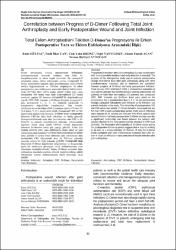Correlation between Progress of D-Dimer Following Total Joint Arthroplasty and Early Postoperative Wound and Joint Infection

View/
Date
2021Author
Gültaç, EmreCan, Fatih ilker
Kılınç, Cem Yalın
Tanyıldızı, Hıdır
Açan, Ahmet Emrah
Aydoğan, Nevres Hürriyet
Metadata
Show full item recordCitation
Gültaç, E. , Can, F. , Kılınç, C. Y. , Tanyıldızı, H. , Acan, A. , Aydoğan, N. "Correlation between Progress of D-Dimer Following Total Joint Arthroplasty and Early Postoperative Wound and Joint Infection" . Muğla Sıtkı Koçman Üniversitesi Tıp Dergisi 8 (2021 ): 91-96Abstract
Postoperative infection after joint arthroplasty is a bad complicationwith incontrovertible incidence and early detection is essential. Thepurpose of this retrospective study was to evaluate postoperativechange of D-Dimer level after joint arthroplasty along with otherproinflammatory mediators and to determine the correlationbetween progress of D-Dimer and early postoperative infection.From January 2017 until March 2018, a retrospective evaluation of121 patients operated for elective primary total hip arthroplasty (49patients) or total knee arthroplasty (72 patients) was conducted.CRP, INR, troponin and D-Dimer level were noted on thepreoperative day 1, postoperative days 1, 3, 7, 14 and perioperativechanges compared. All patients were followed up for infection. 121patients included in the study. The variability of postoperative CRPand INR values was similar. D-Dimer showed a more rapid rise andfall than CRP in early postoperative period. Early wound infectionswere detected in 24 patients (19.8%) and 70% of the patients withwound infection had early postoperative D-Dimer increase and alsoa significant relationship was found between the patients withwound infection in the early period and the increase in CRP level(p<0.05). The fluctuation and instability of D-Dimer values duringthe postoperative follow-up period suggests that it may be unlikelyto be used as a strong indicator of infection. If only the D-Dimerlevels combined with other inflammatory mediators like CRP etc.then it might be effective in early detection of wound infection afterjoint arthroplasty.

















